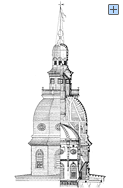History of the State House and Its Dome
On March 28, 1772, Governor Robert Eden laid the
cornerstone for what would be the third State House
built on State Circle in Annapolis. The first, built
soon after the capital was moved from St. Mary's City to
Annapolis in 1695, burned down in 1704. The second was
completed by 1709 and, 60 years later, had become far
too small for the growing business of government and was
too dilapidated to warrant enlarging it. The decision
was made to raze it and Charles Wallace undertook the
work when no one else submitted "plans and estimates"
for the project.
With Mr. Wallace as the "undertaker" and Joseph Horatio
Anderson as the architect, work was begun on the new
State House in early 1772. While work progressed well
for the first year and a half, at least one hurricane
and the Revolutionary War intervened to cause enormous
delays and difficulties. By the end of 1779, the
building was still not completed, and Mr. Wallace's
finances and patience with the project were exhausted.
When the Continental Congress came to Annapolis to meet
in the Old Senate Chamber from November 1783 - August
1784, they found a State House which was still
unfinished. Although the Old Senate Chamber was
complete, the roof was not and it had leaked during the
last few winters, damaging the upstairs rooms. The dome
- or cupola - atop the State House was variously
described as inadequate, unimpressive, and too small for
the building and, it, too, leaked.
In order to rectify the situation, Joseph Clark, an
Annapolis architect and builder, was asked to repair the
roof and the dome. Clark first raised the pitch of the
roof to facilitate the runoff of water and covered it
with cypress shingles. The crowning achievement of
Clark's work on the State House was, of course, the
extraordinary dome which he designed and built. It is
not known where Clark's inspiration for the unusual
design of the dome came from, but it is very similar to
one in Karlsruhe, Germany called the Schlossturm.
By the summer of 1788, the exterior of the new dome was
complete. It was constructed of timber and no metal
nails were used in its construction and, to this day, it
is held together by wooden pegs reinforced by iron
straps forged by an Annapolis ironmonger.
Although the exterior of the dome was completed by 1788,
the interior was not completed until 1797. Tragedy
struck the project in 1793 when a plasterer named Thomas
Dance fell to his death from the inside of the dome. By
1794, Joseph Clark was completely disillusioned with the
project and left it to John Shaw, the noted Annapolis
cabinetmaker, to oversee completion. Over the years,
John Shaw did much of the maintenance work on the State
House, built various items for it and, in 1797, made the
desks and chairs which furnished the Old Senate Chamber.

The State House Dome, Historic American Buildings
Survey, 1985. MSA SC 1173